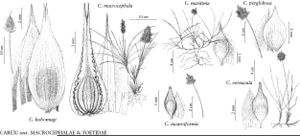Carex vernacula
Bull. Torrey Bot. Club. 20: 417. 1893.
Plants loosely cespitose or colonial. Culms erect, straight, bluntly trigonous, 8–40 cm, smooth to slightly scabrous-angled distally. Leaves: basal sheaths dark-brown; ligules 0.4–1.7 mm; blades flat, shorter than culms, (1.5–) 2–3.5 (–4) mm wide. Inflorescences 0.8–1.6 cm; spikes ca. 5–15, indistinguishable in dense, globose to ovoid head. Pistillate scales reddish-brown to blackish, ± translucent, lacking whitish hyaline margins, ovate, ± equaling perigynia, apex acute to acuminate, body shiny. Anthers 1.5–2.8 mm. Perigynia pale yellowish-brown proximally, reddish-brown to blackish distally and on beak, finely 5–9-veined abaxially, faintly veined or essentially veinless adaxially, flattened, not inflated, narrowly to broadly elliptic, 3.3–4.6 × 1.1–1.9 mm, membranous, shiny; stipe 0.2–0.6 mm; beak well defined, 0.9–1.5 mm, smooth-margined.
Phenology: Fruiting Jul–Sep.
Habitat: Moist alpine tundra, moist forest openings just below treeline
Elevation: 2000–3800 m
Distribution

Calif., Colo., Idaho, Oreg., Wash., Wyo.
Discussion
Carex vernacula is very similar to and often united with the European C. foetida Allioni, which has serrulate-margined perigynium beak and proportionately longer leaves. The numerous distinctions drawn between these two by K. K. Mackenzie (1931–1935, parts 2–3, pp. 29–30) have not proved consistent with examination of more material.
Selected References
None.
Lower Taxa
"shortened" is not a number.
